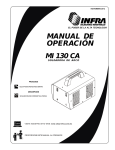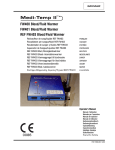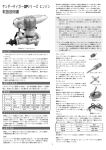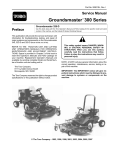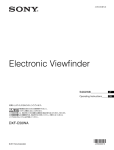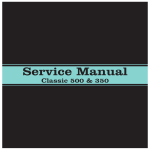Download Manual - Ruberkon
Transcript
PARTS LIST/CARBURETOR FIG DESCRIPTION 9290 A. CARBURETOR BODY PN1113 B. CARB. ROTOR ASSY PN1114 C. NEEDLE VALVE ASSY. PN1115 D. SPRAY BAR ASSY. PN1116 E. NEEDLE VALVE ONLY PN1117 F. THROTTLE LEVER PN1013 G. FUEL INLET ASSY. PN1119 H. RATECHET SPRING AA1181B I. O RING SET PN1118 J. THROTTLE-STOP SCREW SET PN1014 K. SPARY BAR ONLY AA1178 Congratulations on your purchase of a Thunder Tiger four-stroke model engine. This engine represents the latest in Thunder Tiger design and manufacturing techniques, employing advanced CAD design and CNC manufacturing. All major components of Thunder Tiger engines are machined from the highest quality materials in our state-of-the-art manufacturing plant. Engines are then subjected to rigorous quality control checks to ensure that your engine will provide years of trouble free use. F-54S / 9800 1.PROP LOCKNUT SET PN0144 2.PROP WASHER AA0026B 3.DRIVE WASHER AA0477 4.CRANKCASE AA0451 5.CRANKSHAFT AA0454 6.BACKPLATE AA0460 7.CONNECTING ROD AN0458 8.WRIST PIN AA0459 9.CIRCLIP AA0327 10.PISTON AA0456 11.PISTON RING AA0457 12.CYLINDER AA0455 13.CAMSHAFT AA0462 14.CAMSHAFT COVER SET PN0145 15.CAM FOLLOWER SET PN0146 16.PUSH ROD SET PN0147 17.PUSH ROD COVER ASSEMBLY PN0148 18.CYLINDER HEAD AN0452 19.CYLINDER HEAD (W/VALVE ASSEMBLYLY) PN0149 20.INLET VALVE AA0474 21.EXHAUST VALVE AA0475 22.VALVE SPRING SET PN0150 23.SPRING RETAINER SET PN0151 24.SPRING HOLD COLLARS PN0152 25.ROCKER ARM SET PN0153 26.ROCKER ARM SUPPORT SET PN0154 27.ROCKER ARM COVER AA0453 28.INLET PIPE AA0476 29.EXHAUST PIPE SET PN0155 30.BREATHER NIPPLE PN0131 31.GASKET SET PN0156 32.CRANKSHAFT BEARINGS(FRONT) AMV608Z 33.CRANKSHAFT BEARINGS(REAR) AMV16001 34.CAMSHAFT BEARING AMV695ZZ 35.HEAD SCREWS SET PN0157 36.CRANKCASE SCREWS SET PN0158 37.CARBURETOR BOLTS SET PN0159 38.CRANKSHAFT KEY SET PN0160 39.MUFFLER ASSEMBLY 9220 40.CARBURETOR ASSEMBLY 9290 41.CHOKE VALVE ASSEMBLY 9292 IMPORTANT THUNDER TIGER MODEL CO. No. 7, 6th ROAD INDUSTRY PARK TAICHUNG TAIWAN R.O.C. 407 JA0262 Made in Taiwan R.O.C. THUNDER TIGER U.S.A. Inc. ATT: SERVICE DEPARTMENT 2430 LACY LANE, SUITE 120 CARROLLTON, TX 75006 SPECIFICATIONS Engine Displacement Stroke Bore Practical R.P.M. Output Power Weight (w/muffler) F-54S 8.86 c.c / .541 cu.in. 19.6 mm / 0.7765 in. 24.0 mm / 0.9448 in. 1,800 ~ 12,5000 rpm 0.9 HP /12,000 rpm 430 g /15.2 oz. NECESSARY ACCESSORIES INSTRUCTION PARTS LIST/ENGINE FIG DESCRIPTION THUNDER TIGER F-54S 4 STROKE ENGINE OPERATING INSTRUCTIONS This engine will provide you with years of safe use, provided that you carefully follow these safety instructions: 1. This model engine IS NOT A TOY, but a powerful miniature engine that is capable of inflicting damage to both people and property if misused. 2. Always mount the engine securely in a test stand or highquality engine mount. Never, ever attempt to clamp your engine in a vise. 3. When operating your engine keep all spectators at least 20 feet away. 4. Make sure that you use the correct propeller for your engine. Specific recommendations are listed in this manual. 5. Make sure that the propeller nut is securely fastened before each flight. 6. Keep yourself away from the path of the propeller when running your engine. 7. Keep your hands away from the propeller. Always use a "chicken stick" or electric starter to start your engine. 8. Make all adjustments to the engine and carburetor from behind the propeller. 9. Never use your hands or any other part of your body to stop the propeller. Do not throw any object into the propeller to stop the engine. Cut off the fuel supply by removing the fuel line, pinching it closed, or closing the throttle barrel completely. 10. Never use a propeller that is cracked, nicked or damaged in any way. 11.It is recommended that you wear safety glasses when operating any model engine. 12.Do not run your engine around dir t, sand or loose gravel.Such material can be thrown into your eyes by the propeller. In addition, the engine can be damaged by these materials entering the carburetor. 13.Take care to keep all loose clothing, rags, tools, etc. away from the propeller. 14.Keep all fuel lines, glow clips, etc. away from the propeller. 15.Take care when handling your engine after running. Model engines get very hot during operation! 16. Always operate your engine with proper ventilation. Model engines produce toxic fumes when run in a closed room or confined area. The following items are necessary for operating your engine, and are available from your local hobby supplier. Fuel A good quality, commercially available fuel containing 30% oil and 1015% nitro is recommended for use in Thunder Tiger four-stroke engines. Fuels containing a blend of both castor and synthetic oil is best. Fuels containing only castor oil are not recommended! (But during the breaking-in period, it is better for the fuel containing at least 20% lubrication oil.) Glow Plug Due to the mechanics of the four stroke engine, one explosion every two revolutions, are difference with the two stroke engine. So the special type plug should be choosed to fit the four stroke engine. The type and quality of glow plug used in your engine will have a major impact on overall performance and reliability. For Thunder Tiger fourstroke engine,we recommend the following plugs: Thunder Tiger Super 4-T #9283, O.S.- type-F, Saito- P-1, Hangar 9 # 3010 and McCoy - MC-4C. Glow Starter The electric power source for heating the glow plug. This can be a simple 1.5v Hobby Battery with a locking socket (TTR 2176) or a selfcontained, rechargeable unit such a TTR 2170. Plug Wrench Used for tightening the glow plug as well as the propeller nut. TTR 1102 4-way wrench is recommended. Fuel pump or bottle Required to fill the fuel tank in your model. A Thunder Tiger hand-crank pump (TTR 1645) or 12v electric pump (TTR 1658) are available from your hobby dealer. Chicken Stick/ Safety Stick Used to flip the propeller when starting the engine by hand. NEVER use your fingers to start a model engine! Electric Starter An electric starter is an easy way to start your Thunder Tiger engine. Used with a 12 volt battery, it is the safest and most convenient starting method. Propeller Suggested propeller sizes are shown in the table below, with allowances for different types of aircraft and performance goals. Keep in mind that factors such as aircraft weight, size, style and type of flying will affect your choice of props. After break-in, select the optimum prop size by practical flying tests. Begin your tests with the suggested propeller sizes in the table below: Engine F-54S Breaking-in 11x5 Stunt 10X9,10X10,11X5, 11X6,11X7,11X8 Caution: It is very important to use a well balanced propeller and spinner only. An unbalanced propeller or spinner can cause substantial damage to both the aircraft and engine. Fuel Tank Choose the proper fuel tank as recommended by the manufacturer of your airplane kit. Thunder Tiger has a series of new tanks that are available at your hobby dealer. Fuel Line Choose a high quality, silicone fuel line for use with your Thunder Tiger engine. INSTALLATION OF THE ENGINE Mount your engine securely to rigid hardwood rails (e.g. maple) or a radial engine mount of metal or glass-filled nylon composition. The top surfaces of the motor mount must be absolutely flat and parallel to avoid crankcase distortion and stress. Be sure to use only the highest quality mounting hardware such as hardened steel screws, etc. In order to reduce engine noise, a flexible engine mount can also be used. The outside dimensions of this engine are shown at FIG.1. Fuel Tank The fuel tank should be mounted as close to the engine as possible. Ideally, the center line of the tank should be level with the needle valve. The design of your aircraft will determine the actual tank location, but use the above instruction as a guide. Keep in mind that tank location can have a major impact on engine performance. Make sure that your entire fuel system is sealed and well constructed to eliminate the possibility of fuel or air leakage. If possible, wrap your fuel tank with high quality foam rubber to reduce fuel foaming from airframe vibration. Glow Plug Use a 4-way wrench to insert the glow plug into your engine. Be careful not to use excessive force, but make sure the plug is tight and the copper washer is properly sealed beneath the glow plug. Muffler After the engine is mounted in your model or test stand, secure the muffler to the exhaust pipe. Screw the exhaust pipe into the cylinder head at the desired angle and secure with the jam nut. Propeller Mount the suitable propeller securely to your engine. If using a spinner, make sure that the cut-out area for the propeller blades offer adequate clearance so that no part of the prop is touching the spinner. Caution: If a four-stroke engine is run too lean or under excessive loads, pre-ingitation occurs in the combustion chamber (called "knocking" or "detonation"). This condition will cause an unuaual vibration in the engine, and could possibly cause engine damage! The biggest danger, however, is that this vibration offten loosens the prop nut and sends the propeller flying off the engine. Make absolutely certain that the prop nut is fastened securely! BREAK-IN THE ENGINE Proper break-in is critical to the life of any model engine. During this period, the precision metal parts of the engine are properly mated and worn in. It is critical that the engine be run in an area free from excessive dirt and sand. Your engine may be broken-in on a test bench or in your model. Either method is fine, however a test bench allows you to keep the engine away from dirt as well as making adjustments simpler. Break-in checklist: a. Use the proper fuel and glow plug as described in NECESSARY ACCESSORIES. b. Select the proper propeller as recommended in the propeller chart. c. Make sure that the high-speed needle valve is opened 2-2 1/2 turns. d. We strongly recommend the use of a tachometer when tuning a four-stroke engine. Although the carburetor adjustments are the same, four-stroke engines cannot be tuned by sound like a 2-stroke. Use of a tachometer will eliminate the possibility of damaging your engine by running it too lean. Starting the Engine a. Make sure that the glow plug and propeller are installed and properly tightened. b. Be sure that the fuel lines are properly connected, with the fuel pick-up connected to the carburetor and the pressure line connected to the muffler pressure nipple. c. Make sure that the muffler is properly installed. d. Fill the fuel tank. e. Prime the engine using the following steps. (Make sure the glow plug igniter is NOT connected!) 1. Open the carburetor to full throttle. 2. Close the choke valve. 3. Rotate the prop counter-clockwise by hand 7 or 8 revolutions, or until you notice fuel draining from the carb. f. Open the choke valve. g. Adjust the throttle to 25% open. h.Rotate the prop clockwise until you feel the prop hit the compression stroke. i. Connect the glow plug igniter. j. Start the engine counterclockwise using an electric starter or "chicken stick". Caution: When using an electric starter, never attempt to start a flooded engine. Although the electric starter may turn the engine over, it can damage the connecting rod or other components. If the engine becomes flooded, simply remove the glow plug and turn the engine over with the electric starter or "chicken-stick". The excess fuel will be forced out the glow plug hole. During Break-In: a. Do not exceed 5,000 R.P.M. during the first five minutes of operation. b. Because of the extremely rich needle setting used during breaking-in, you may wish to keep the glow plug igniter attached. c. After consuming the first tank of fuel, allow the engine to cool. You can then re-start the engine and gradually lean the needle setting during the next few tanks. d. During the third tank of fuel, lean the needle valve for optimum R.P.M. using the tachometer, then richen the mixture until a drop of 200-300 R.P.M. occurs. CARBURETOR ADJUSTMENTS The air-bleed carbruetor with a throttle rotor and an air-bleed screw provides a wide range of engine speed control from idling speed to full power. The throttle rotor with the throttle lever linked to a servo under the control of R/C system in your model will enable engine speed to be varied. As the carburetor of your engine has been factory set for approximate the best running with fuel tank is correctly located as previously described, it should not be required to adjust anything except the needle valve. After the engine has been broken-in, check the operation of the throttle according to the following and re-adjust the air-bleed screw when necessary. THROTTLE-STOP SCREW ADJUSTMENT 1) Start the engine and open the throttle fully. 2) Adjust the needle valve to the best position. 3) Close the throttle gradually from the highest speed to the lowest possible. 4) Find and fix the idling position where the lowest possible R.P.M. with steady running is obtained by means of the "throttle trim" on your transmitter or by screwing the throttlestop screw without risk of the engine stopping. 5) Open the throttle fully and make sure that the engine runs at the highest speed, or else (i.e. your engine stops) re-set the idling position at a little higher R.P.M.. 6) Keep running at the highest speed for about 10 seconds, then close to the lowest speed abr uptly. Run at idling for about 5 seconds and make sure it does not stop, or else reset the idling position at a little higher. 7) Repeat the procedure 5) abruptly, then the procedure 6) for few times to ensure the best running is obtained. If your engine stop in the middle range or it is not the best to speed up from idling to full power, please adjust the air-bleed screw as follows: AIR-BLEED SCREW ADJUSTMENT 1) Start the engine and open the throttle fully. 2) Adjust the needle valve to the best position. 3) Close the throttle gradually from the highest speed to the lowest possible. 4) Find and fix the idling position where the lowest possible R.P.M. with steady running is obtained by means of the "throttle trim" on your transmitter or by screwing the throttlestop screw without risk of the engine stopping. 5) In order to determine which way to adjust, determine firstly the present condition of the idle fuel mixture. Hold your aircraft with arms as illustrated and nose up approximate 15 slowly. CONDITION 1 If the engine runs unevenly or stops, nose down your aircraft immediately approximate 15 . The engine should run steadily. Stop the engine by pinching the fuel line and close (clockwise) the air-bleed screw about 1/2 turn. These adjustment can be made without stopping the engine. However, it is advisable for beginners to stop the engine for safety reasons. CONDITION 2 If the idling runs up, stop the engine and open the air-bleed screw about 1/2 turn. 6) Re-start the engine, and repeat from the procedure 3) to 5) until a steady idle is obtained. NOTE After the needle valve is adjusted on procedure 2), do not attempt to adjust it again. ?W26X?hg ?7<B1?hg ?@e@?hg ?3=C5?hg ?V40Y?hg ?W2@6X ?7<?B1 ?@e?@ ?3=?C5 ?V4@0Y Installation of the Camshaft The position of the camshaft determines the timing of your engine. An improper camshaft position will cause serious engine damage even engine may not be start. It is strongly suggested that you Do Not Dismantle the camshaft . If for some reasons, you need to disassemble or change the camshaft and as you re-install the camshaft, please follow the following procedures : a. Turn the crankshsft to the T.D.C. (top dead center). (There is a T.D.C. mark on drive washer, set this mark on the top position.) b. Apply some light oil (3-in-1, Mystery oil. etc.) to the camshaft. c. Note that there is a mar k on the side surface of the gear. When re-installing the camshaft, the mark must point to the upside cam cover screw hole. ( Refer to FIG.3.) d. Install the cam cover and properly secure the two screws. e. Rotate the crankshaft several revolutions to insure the camshaft is properly seated, then reassemble the rest parts of the engine. ENGINE CARE Always keep the outside of your engine clean. Use clean, fresh fuel and keep your fuel can, pump, and fueling system free from dirt particles. Install a fresh filter between the fuel tank and carburetor, and between your fuel pump and filling line to prevent any dirt from entering your engine. Model fuel contains alcohol, which is hydroscopic (meaning that it attracts moisture from the atmosphere). This can cause corrosion to the internal engine parts. After each flying session, run all the fuel out from inside the engine and disconnect the fuel line from the carburetor. Put 4 or 5 drops of after-run oil (Marvel Mystery Oil, Prather, Pacer, etc.) into the carburetor and turn the engine over several times by hand to protect the engine bearings and internal parts from corrosion. The use of after-run oil is also important during periods of prolonged storage (such as winter). We suggest removing the engine from the model, liberally applying oil into the carburetor and glow plug hole, and wrap your engine in a soft cloth and store in a sealed plastic bag. If you choose to store your engine in the airplane, make sure to store the model with the engine down so as to keep the bearings lubricated. Do not dismantle your engine unnecessarily, as this may upset precision fits such as piston/cylinder and valve/tappet assemblies. If it is necessary to completely clean your engine, remove only the carburetor (do not disassemble), muffler and exhaust pipe. Flush the entire engine with fresh fuel and reassemble. Valve Clearance Adjustment The valve clearances on your engine are factory set and will seldom require adjustment. However, after a considerable amount of running time you detect a loss of power, or if the engine must be disassembled after a crash, the valve clearances should be checked and adjusted. The valve adjusting kit , containing two gauges and one wrenche, are enclosed in the box. Note: Valve clearances MUST be checked when the engine is COLD. a. Remove the rocker arm cover. b. Turn the propeller until you feel compression, then turn it an additional 1/4 turn and stop. Both valves should be closed now. c. The required valve clearance is .03mm - 0.10mm (.0012 .004) measured between the valve stem and rocker arm. A .03mm shim should pass through the gap, 0.10mm should not. (Refer to Fig.2) Caution: Incorrect valve clearances can cause difficult starting, erratic operation and loss of power. THUNDER TIGER 3 YEARS LIMITED WARRANTY Your engine is guaranteed to be free from defects in materials and workmanship for a period of 3 years from the date of purchase when returned for service accompanied by proof of purchase (register receipt, credit card invoice, etc.). Crash damage or problems caused by improper use are specifically not covered under this warranty. Damage caused by customer disassembly, use of improper or substandard fuel, use of improper accessories (such as propellers, glow plugs, etc.) or any use of product other than its specific intended use will automatically void this warranty. SERVICE PROCEDURES Should your Thunder Tiger engine require service, please follow the following guidelines: 1. Do not return the engine to the place of purchase, as they are not authorized or equipped to perform service. 2. Remove the engine from the model. We cannot accept equipment for service other than engine. 3. Along with your engine and proof of purchase, enclose a complete written explanation detailing the problem(s) with your engine. Be sure to include your name, address and daytime telephone number. 4. For repairs not covered under warranty, the charges will be billed to you C.O.D. Please mention if you wish to have an estimate of nonwarranty repair charges prior to us beginning service. (This may cause a slight delay in your repair.) 5. For customers outside of the U.S. and Canada, contact the authorized Thunder Tiger agent in your country. 6. For U.S. and Canadian customers, send your engine via insured mail or U.P.S. to the Thunder Tiger Service Center. The address can be found on a seperate sheet included with your engine. TROUBLE SHOOTING GUIDE SYMPTOM Engine will not fire Engine fires but will not run CAUSE discharged starting battery Over primed Incorrect glow plug CORRECTIVE ACTION Low voltage or Replace/recharge starting battery Disconnect battery and rotate prop several times to clear engine, Verify plug type Engine starts but slows down then stops Mixture too rich Close needle valve 1/4 turn until engine runs smoothly Engine starts,speeds up,then stops Mixture too lean Open needle valve 1/4 turn until engine runs smoothly Engine quits when starter battery is removed Mixture too rich, Incorrect glow plug, Improper or bad fuel Close needle valve 1/4 turn and restart Change glow plug, Change fuel


